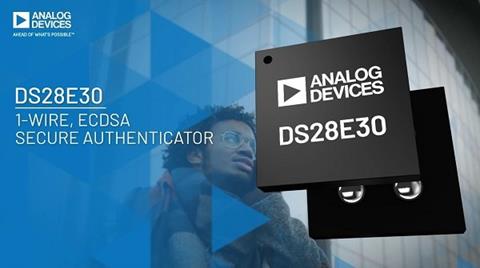DS28E30
RECOMMENDED FOR NEW DESIGNS1-Wire ECDSA Secure Authenticator
The DS28E30 Provides a Highly Secure and Easily Deployed Turnkey Authentication Solution with ECDSA.
- Part Models
- 5
- 1ku List Price
- Starting From $0.71
Part Details
- Robust Countermeasures Protect Against Security Attacks
- All Stored Data Cryptographically Protected from Discovery
- ECC P-256 Secure Compute Engine
- Preprogrammed and Write-Protected ECC P-256 Key Pair
- FIPS 186-4 Compliant ECDSA for Strong Challenge/Response Authentication
- ECDSA Authenticated R/W of Configurable Memory
- TRNG Used for Secure ECDSA Nonces
- Supplemental Features Enable Easy Integration into End Applications
- 17-Bit, One-Time Settable, Nonvolatile Decrement-Only Counter with Authenticated Read
- 3Kb of Secure EEPROM for User Data, Keys, Certificate, and Secure Counter
- Unique and Unalterable Factory-Programmed, 64-Bit Identification Number (ROM ID)
- Authenticity Verification with ECDSA Using Preprogrammed Maxim Certificate
- Advanced 1-Wire Protocol Minimizes Interface to Single Contact
- Full-Time Overdrive Communication Speed
- Operating Range: -40°C to +85°C, 1.62V to 5V
- 4-Bump WLP and 6-Pin TSOC Packages
- 3.5μA (typ) Input Load Current
- High ESD Immunity of 1-Wire Pin: ±8kV Human Body Model (HBM), typ
The DS28E30 provides a highly secure and easily deployed turnkey authentication solution based on the FIPS-186 ECDSA standard. The secure authenticator combines ECDSA challenge and response authentication with secured EEPROM for the storage of the keys and user data.
The device provides a core set of cryptographic tools derived from integrated blocks including an asymmetric hardware engine, a true random number generator (TRNG), 3Kb of secure EEPROM, a decrement-only counter, and a unique 64-bit ROM identification number (ROM ID). The ECC public/private key capabilities operate from the NIST-defined P-256 curve to provide a FIPS 186-compliant ECDSA signature generation function to support a bidirectional asymmetric key authentication model. The unique ROM ID is used as a fundamental input parameter for cryptographic operations and serves as an electronic serial number within the application. In addition, authenticity of the chip can be verified with a Maxim-provided public key certificate. The device communicates over the single-contact 1-Wire® bus at overdrive speed. The communication follows the 1-Wire protocol with the ROM ID acting as a node address in the case of a multidevice 1-Wire network.
Applications
- Accessory and Peripheral Secure Authentication
- Battery Authentication and Charge Cycle Tracking
- Medical Tools/Accessories Authentication and Calibration
Documentation
Data Sheet 1
User Guide 1
Technical Articles 1
Video 2
ADI has always placed the highest emphasis on delivering products that meet the maximum levels of quality and reliability. We achieve this by incorporating quality and reliability checks in every scope of product and process design, and in the manufacturing process as well. "Zero defects" for shipped products is always our goal. View our quality and reliability program and certifications for more information.
| Part Model | Pin/Package Drawing | Documentation | CAD Symbols, Footprints, and 3D Models |
|---|---|---|---|
| DS28E30/W+ | N/A | ||
| DS28E30P+ | Thin Small-Outline C-Lead | ||
| DS28E30P+T | Thin Small-Outline C-Lead | ||
| DS28E30X+T | 4-WLCSP-N/A | ||
| DS28E30X+U | 4-WLCSP-N/A |
This is the most up-to-date revision of the Data Sheet.
Software Resources
Can't find the software or driver you need?
Request a Driver/SoftwareTools & Simulations
Software Development 1
DeepCover® Security Lab
Open Tool




